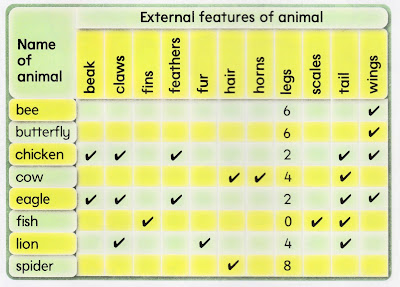Mixing Substances
01:25 |
Labels:
LEARNING ABOUT THE WORLD AROUND US
1) The Properties of Substances
Mixing Substances with Water and with Vinegar
The table below shows the result of mixing substances with water and with vinegar. Some substances such as sugar and salt dissolve in water and in vinegar.
2) Unsafe Substances
Unsafe substances always have words such as "Caution" or "Warning" on the labels. These words tell us to be careful when we handle the substances.
Some substances are unsafe. They have labels and are usually kept in containers. They also have certain symbols on their containers.
The labels and symbols on the containers tell us how the substances can cause harm. They also tell us how to handle the substances carefully.
Do not touch, smell or taste any substance before reading the label or asking an adult about it.
3) A Mixture of Substances Can Be Separated
A mixture of substances can be separated in different ways. You can decide how to separate the mixture according to the properties of the substances in it.
A mixture of substances can be separated using a filter funnel and filter paper, magnet or sieve.
Soil
1. State 'True' or 'False'.
a) Water flows very well through sand.
b) Many plants can grow well in clay soil.
c) Garden soil is soft and black in colour.
d) Plants can only grow in garden soil.
e) Some animals live in soil.
2. Complete the table with the correct words given below.
Plants
1) Name two plants with:
a) woody stems :
b) soft stems :
c) flowers :
d) rough leaves :
e) smooth leaves :
f) dull leaves :
2) Name the external features of these plants.
a) Croton :
b) Orchid :
c) Bird's nest fern
Animals
1. A bird's body is covered with .
2. A butterfly has two pairs of .
3. Cats and tigers have very sharp .
4. A chicken uses its to eat.
5. A caterpillar has many .
6. A buffalo has on its head.
7. Snakes and fish have on their bodies.
Layer of soil
01:03 |
Labels:
LEARNING ABOUT THE WORLD AROUND US
The heaviest things will sink to the bottom of the bottle.
Above them are layers of lighter things.
Some dead plants and animals float in the water.
SOIL
18:15 |
Labels:
LEARNING ABOUT THE WORLD AROUND US
What Soil is Made Up of?
- — Soil is made up of stones, sand, clay, silt and bits of dead animals and plants.
- — Living things such as worms and ants are found in the soil.
The layer of soil
The Flow of Water
through Soil
What we have learnt ?
1. Soil is made up of sand, silt, clay, stones and bits of dead plants and animals.
2. When plants and other living things die, they rot and become part of the soil.
3. Soil also has living animals in it such as earthworms and ants.
4. There are many types of soil such as sandy soil, clay soil and garden
soil.
5. Different types of soil let water flow through them differently.
6. Plant can grow well in garden soil that contains enough water.
Click for the information:
PLANTS
20:27 |
Labels:
LEARNING ABOUT LIVING THINGS
1. Plants can be identified by their external features.
2. Plants can be grouped according to their similar external features.
3. Plants with similar external features can also be grouped in other ways.
Plants can be grouped in many ways according to their external features. A group of plants can be divided into other different groups. For example, the plants below are grouped into one group because all of them have thorns and green leaves.
The pineapple plant and the aloe vera have long leaves. So, we can group them into one group. The rose plant and the bougainvillea have oval shaped leaves. So, we can group them into another group.
ANIMALS
18:12 |
Labels:
LEARNING ABOUT LIVING THINGS
1. Animals can be identified by their external features.
2. Animals with similar external features can be grouped together.
3. A group of animals can be divided again into different groups.
Animals can be grouped in many ways according to their external features. A group of animals can be divided again into different groups. For example, the animals below are grouped into one group because each of them has four legs and a tail.
Tiger and lions have claws and fur. Goat and cows have horns and hair. So, we can group these animals into two different groups.
Subscribe to:
Comments (Atom)























.jpg)
.jpg)
.jpg)
.jpg)
.jpg)







